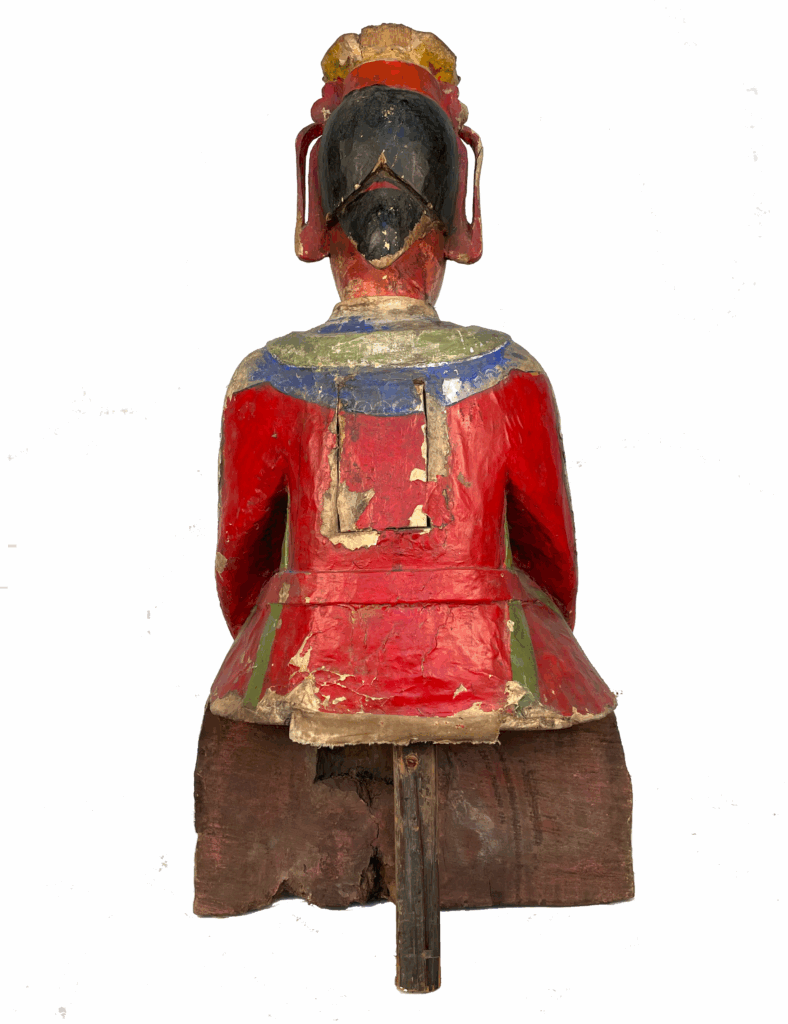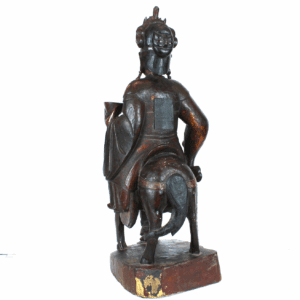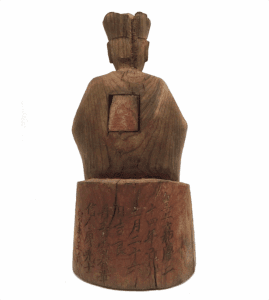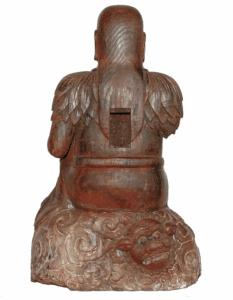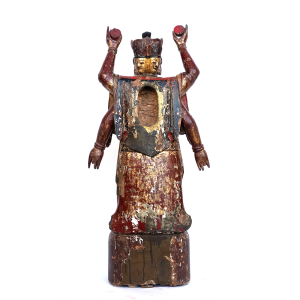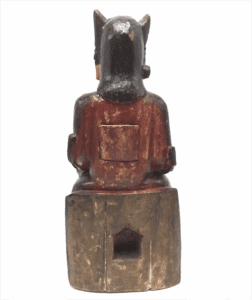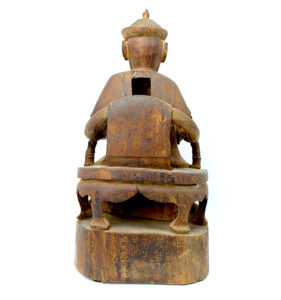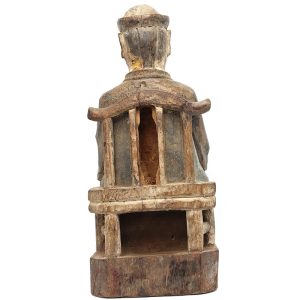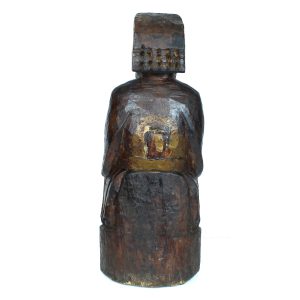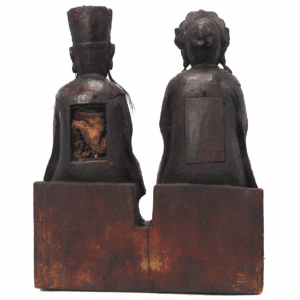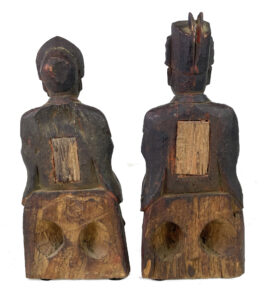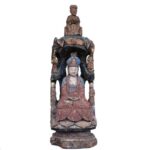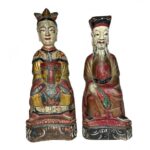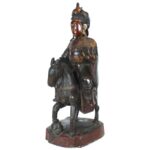Consecrating Wooden Images to Imbue Them with a Life Force
Carved figural statues have historically been an integral part of cultural and religious life in China, providing spiritual inspiration, solace, and dedication to the country, local communities, families, and individuals. The statues fulfilling these functions were never created to be solely objects of decoration; rather they were used for didactic purposes for illiterate populations, and as a expression of Ancestor Worship to honor and maintain ongoing relationships with the previous generations. Chinese homes, clan halls, temples, and public community buildings contained altars and shrines to honor and venerate familial ancestors and a multiplicity of gods and deities. These dedicated altars and shrines were sacred spaces to express spiritual reverence, ward off malevolence, and bring good fortune to the living descendants and their environments. The configuration and size of the altars and shrines were a reflection of the family’s status and financial status. In most Chinese homes altars were modest fabrications, sometimes a single table set near a wall, where the family could honor and communicate with their ancestors and express Confucian familial piety, a tradition central to the Chinese way of life that was required by all families.
In wealthy homes, altars and shrines were located in a distinct separate room as a dedicated and revered space that included images (paintings, drawings, photos, or other images) of deceased ancestors on the wall behind the altar or on the altar itself. Ancestral tablets (also called memorial or spirit tablets) might also be there as a simple placard or a more costly item carved in wood, metal, or other materials to designate the “seat” of the deceased ancestor. His/her name, birth and death dates, and a biographical detail or two would be included. Tablets are repositories for the spirit of ancestors and can be made for an ancestor or a married couple, as well as for deities, gods, or spirits included from different faiths including Buddhism, Taoism, Popular Folk Religions, and other beliefs. Temple halls were also used to house tablets to faithfully honor and remember the departed and can be still be seen in contemporary temples. Once a tablet is placed in a Buddhist or Taoist temple, ancestors can receive the benefit of monks’ prayers for the deceased to aid them in the afterlife, and the family would not be required to make incense and food offerings to them regularly at their home altar.
Wood carvings of Buddhist, Taoist and Popular Religion images including deities, significant priests, important monks, ancestors, officials, and historical and mythical deified figures, were blessed and sanctified by a senior priest or monk to imbue the carving with vital energy or life force (chi, ki, qi, prana) through a consecration ritual called an “eye opening ceremony.” This was performed before the carving was placed on a public or private altar or shrine and was sometimes accompanied by a carved dedication inscription on the rear and/or sides of a statue showing the name, date, and donors of the statue and the monk consecrating the image. Most inscriptions are composed of a few characters, but others can be very complex.
There are various Chinese terms for consecrating a piece: kaiguanag or “opening of light,” kaiyan or “opening the eyes,” and dianyan or “dotting the eyes.” All are seen as opening the senses to enable the statues’ spirits to see, hear, and respond to the requests from devotees. Some forms of eye-opening ceremonies have been practiced with minor variance in all regions throughout South, Southeast, and East Asia. In China where consecrating ceremonies are pervasive, the details and practices of the ceremonies differ in varying degrees depending on the location and religious tradition, whether it be Buddhism, Taoism or Popular Folk Religion. It is also still practiced to bring life to Chinese lions or dragons before they are used in dances during the Chinese New Year and other Chinese traditional, cultural and religious festivals. Mahayana and Tantric Buddhist images for home altars and temple settings were consecrated by Buddhist monks while Taoist Deities were consecrated by Taoist priests.
Statues to be placed on a shrine or altar contain a cavity specifically carved into the back of the figure to house documents to be placed inside which may include a consecration script written by the priest or monk noting the name of deity or figure; who, for whom and the reason the item was commissioned; the date, location, and temple name where the ritual took place; requests to deities for favors; or other documents. Cavities came in all shapes and sizes, depended on the statue’s size and what was anticipated to be placed inside. Some were integrated into the overall design or carving scheme of back of the image, curved to follow the statue’s body form, rounded or oval, long and thin, or short and squat. In addition to the consecration script, other items might include prayers, favored sutras or other religious tracts suitable for the deity or loved by the donor written on paper, rice paper or silk which were folded into a piece of red paper and sometimes included coins. In some areas the cavity included contents symbolizing inner organs such as sticks or twigs, string, metal, and cotton wrapped and tied in a bundle of multi- colored threads that represented the bones, veins, arteries, and entrails of the humanized figure. Sometimes, although rarely, there were two cavities and for small figurines inscriptions were carved on the back where the cavity would have been carved.
The carver presented the finished statue to the person or family who commissioned it prior to the ceremony. A cowl or red paper was placed over the lifeless image’s eyes, and it was solemnly carried to the temple. Rituals associated with the consecration were complex and reflected the spiritual beliefs and the social and financial status of the family members for whom the consecration was performed. The ceremony began by welcoming the statue and a request for the deity’s spirit to enter the carving. The religious official then placed written materials and accompanying items inside the cavity.
Many families followed all three dominant Chinese religions – Buddhism, Taoism and Popular Folk Religion – which often overlapped with blended beliefs and deities, but all believed that devotee who commissioned the carving and consecrating of spiritual images would earn merit and enhance their karma. The carver, the donor(s), relatives and friends, and other devotees in the congregation participated in the ceremony which may be performed by a Buddhist monk, a Taoist priest, other senior religious leaders, or those involving Chinese Popular Religions or other sects or organizations.
The final consecration step made the statue worthy of reverence, brought it to life, and imbued it with chi or qi (life a force or life energy). Although practices varied among different geographic locations and religions, most concentration centered on bringing “sight” to the image, focusing on rituals related to the eyes. One or more practices were performed by the spiritual officiator to imbue the image with sight: the pupils were created by dotting the eyes with red cinnabar pigment applied with a calligraphy brush, the eyes were pricked with a pin, and/or they were anointed with an oil or liquid. A drop of a red substance, usually blood from a rooster sacrificed during the ritual, might be spread on the piece or used to dot the eyes, and sometimes a live insect, often a cricket, and a few grains of rice or other seeds were placed in the cavity to transfer life and sound to the deity. This process invested an inert woodcarving with a vital energy and a life force. Some believe that the energy of the deity personified by the carving would then inhabit the statue.
The cavity was sealed with a flat piece of wood called a bung with an adhesive on its sides. It was also permanently sealed with paint, lacquer or both to make it tamper proof, assure articles inside remained eternally in the cavity and the artistic integrity of the piece was maintained and perhaps to make it inconspicuous or tempting to less trustworthy viewers. The priest/monk then offered dedicatory prayers for the donor, requested blessings for guests and others witnessing the ceremony, and asked the deity or spirit of statue grace the temple with their presence by inhabiting the statue and bring blessings to all. When the “eye opening” ceremony was completed the red eye covering was removed and discarded.
In Chinese traditions, it is believed that the spirit of an image remains in the statue as long as the contents are contained and sealed in the cavity. Consecrated Buddhist, Taoist, and Popular Folk Religion statues are considered animated and sacred works containing a living spirit and through consecration empty effigies of deities are empowered to be filled with a divine essence. When the consecrated figures were abandoned, discarded, or sold, the bung and cavity contents were usually removed, thus it is rare and exceptional to have an original sealed bung containing its original contents. Some images have open bungs revealing their contents, others have new bungs and others are empty. In deference and respect for these beliefs, we will never open a bung or tamper with or remove a cavity’s contents even if the bung has been removed. We hope all who ultimately possess these items will maintain the same reverence and veneration for these sacred pieces
Sources:
- Stephan Feuchtwang, Popular Religion in China: The Imperial Metaphor, London, Routledge Curzon, 2001.
- Keith Stevens, Chinese Gods: The Unseen World of Spirits and Demons, London, Collins & Brown Limited, 1997.
- Keith G. Stevens, Images of Asia: Chinese Mythological Gods, New York, Oxford University Press, 2001
- Keith Stevens, “An Unusual and Extraordinary Ancestral Image,” Journal of Hong Kong Volume 13, 1998
- Michele Wang, Early Chinese Buddhist Sculpture as Animate Bodies and Living Presences, ARS Orientalis, https://asia.si.edu/research/ars-orientalis/volume-46/

